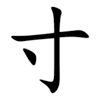寸
| ||||||||
| ||||||||
Translingual
| Stroke order | |||
|---|---|---|---|
 | |||
Han character
寸 (Kangxi radical 41, 寸+0, 3 strokes, cangjie input 木戈 (DI), four-corner 40300, composition ⿹𬺰丶)
- Kangxi radical #41, ⼨.
Derived characters
Descendants
References
- Kangxi Dictionary: page 293, character 32
- Dai Kanwa Jiten: character 7411
- Dae Jaweon: page 581, character 4
- Hanyu Da Zidian (first edition): volume 1, page 503, character 8
- Unihan data for U+5BF8
Chinese
| simp. and trad. |
寸 | |
|---|---|---|
Glyph origin
| Historical forms of the character 寸 | |||
|---|---|---|---|
| Western Zhou | Warring States | Shuowen Jiezi (compiled in Han) | Liushutong (compiled in Ming) |
| Bronze inscriptions | Qin slip script | Small seal script | Transcribed ancient scripts |
 |
 |
 |
 |
Shuowen considered it Ideogram (指事) – a position on the forearm where the pulse can be palpated by compressing the radial artery. It is called 寸口 in modern Chinese, and the meaning of a unit of measurement is derived from the distance between the wrist and this position. Compare 又, 手, 九, 爪.
However, it may be an abbreviated form of 尊 (zūn), borrowed to mean a unit of measurement (see: 李轶.先秦度量单位"尺""寸"用字考[J].云南师范大学学报(哲学社会科学版), 2010, 42(5).DOI:10.3969/j.issn.1000-5110.2010.05.017.)
Pronunciation
Definitions
寸
- (units of measure) A cun or Chinese inch, a traditional unit of length of about 3 cm.
- (Mainland China) Short for 市寸 (shìcùn).
- (Hong Kong) Legally defined as the tsun of 3.71475 cm.
- (informal) Short for 英寸 (yīngcùn, “inch”).
- (figurative) very short or little
- (traditional Chinese medicine) cunkou pulse; radial artery pulse at the wrist
- (Mandarin, colloquial) coincidental; unbelievable; opportune
- a surname
Compounds
- 一寸丹心
- 一寸秋波
- 一寸赤心
- 三寸丁
- 三寸之舌
- 三寸舌
- 三寸貨/三寸货
- 三寸金蓮/三寸金莲
- 京八寸
- 公寸 (gōngcùn)
- 分寸 (fēncùn)
- 寸兵
- 寸兵尺鐵/寸兵尺铁
- 寸功 (cùngōng)
- 寸口
- 寸善片長/寸善片长
- 寸土 (cùntǔ)
- 寸土寸金 (cùntǔcùnjīn)
- 寸土尺地
- 寸地尺天
- 寸子
- 寸心 (cùnxīn)
- 寸指測淵/寸指测渊
- 寸斷/寸断 (cùnduàn)
- 寸晷
- 寸木岑樓/寸木岑楼
- 寸札
- 寸楮
- 寸步 (cùnbù)
- 寸步不離/寸步不离 (cùnbùbùlí)
- 寸步難移/寸步难移
- 寸步難行/寸步难行 (cùnbùnánxíng)
- 寸田
- 寸甲不留
- 寸田尺宅
- 寸男尺女
- 寸碧
- 寸祿/寸禄
- 寸積銖累/寸积铢累
- 寸絲不挂
- 寸絲半粟/寸丝半粟
- 寸縷/寸缕
- 寸腸/寸肠
- 寸草
- 寸草不生 (cùncǎobùshēng)
- 寸草不留
- 寸草心
- 寸草春暉/寸草春晖
- 寸衷
- 寸進/寸进
- 寸金
- 寸鐵/寸铁
- 寸長/寸长
- 寸長尺技/寸长尺技
- 寸長尺短/寸长尺短
- 寸陰/寸阴
- 寸陰尺璧/寸阴尺璧
- 寸陰若歲/寸阴若岁
- 寸隙
- 寸馬豆人/寸马豆人
- 尺寸
- 尺寸之功 (chǐcùn zhī gōng)
- 尺寸之地
- 尺寸千里
- 尺寸斗粟
- 尺短寸長/尺短寸长
- 幫寸/帮寸 (bāngcùn)
- 徑寸/径寸
- 得寸思尺
- 得寸進尺/得寸进尺 (décùnjìnchǐ)
- 得尺得寸
- 愁腸寸斷/愁肠寸断
- 手無寸鐵/手无寸铁 (shǒuwúcùntiě)
- 掉三寸舌
- 方寸 (fāngcùn)
- 方寸之地
- 方寸之間/方寸之间
- 方寸亂矣/方寸乱矣
- 方寸已亂/方寸已乱
- 有分寸
- 柔腸寸斷/柔肠寸断 (róuchángcùnduàn)
- 桐棺三寸
- 沒分寸/没分寸
- 沒尺寸/没尺寸
- 火寸
- 爛頭寸/烂头寸 (làntóucùn)
- 片接寸附
- 猿腸寸斷/猿肠寸断
- 獨守尺寸/独守尺寸
- 積銖累寸/积铢累寸
- 聊表寸心
- 肝腸寸斷/肝肠寸断 (gānchángcùnduàn)
- 英寸 (yīngcùn)
- 言身寸
- 詘寸伸尺/诎寸伸尺
- 詘寸信尺/诎寸信尺
- 調頭寸/调头寸
- 身無寸縷/身无寸缕
- 軋頭寸/轧头寸
- 迴腸寸斷/回肠寸断
- 進寸退尺/进寸退尺
- 銖積寸累/铢积寸累
- 雞屎落塗,也有三寸煙/鸡屎落涂,也有三寸烟 (ke sái lo̍h thô͘, iā ū saⁿ chhùn ian) (Min Nan)
- 頭寸/头寸 (tóucùn)
- 風檐寸晷/风檐寸晷
- 風簷寸晷/风檐寸晷
- 鼠目寸光 (shǔmùcùnguāng)
Etymology 2
| For pronunciation and definitions of 寸 – see 忖 (“to ponder; to speculate; to think; etc.”). (This character is a variant form of 忖). |
Pronunciation
References
- “寸”, in 漢語多功能字庫 (Multi-function Chinese Character Database), 香港中文大學 (the Chinese University of Hong Kong), 2014–
Japanese
Noun
寸 • (sun)
- a Japanese measurement of length equivalent to 10 分 (bu) or approximately 3.03 cm
- (by extension) a length, measurement
- shortness, fewness
- This term needs a translation to English. Please help out and add a translation, then remove the text
{{rfdef}}.
Derived terms
Descendants
- English: sun
Derived terms
Derived terms
- 八寸 (yaki)
References
- Matsumura, Akira, editor (2006), 大辞林 [Daijirin] (in Japanese), Third edition, Tōkyō: Sanseidō, →ISBN
Korean
Etymology
From Middle Chinese 寸 (MC tshwonH).
| Historical Readings | ||
|---|---|---|
| Dongguk Jeongun Reading | ||
| Dongguk Jeongun, 1448 | 촌〮 (Yale: chwón) | |
| Middle Korean | ||
| Text | Eumhun | |
| Gloss (hun) | Reading | |
| Hunmong Jahoe, 1527 | ᄆᆞᄃᆡ (Yale: mòtòy) | 촌〯 (Yale: chwǒn) |
Pronunciation
- (SK Standard/Seoul) IPA(key): [t͡ɕʰo̞(ː)n]
- Phonetic hangul: [촌(ː)]
- Though still prescribed in Standard Korean, most speakers in both Koreas no longer distinguish vowel length.
Compounds
Okinawan
Readings
- On (unclassified): しん (shin)←すぃん (sin, historical)
Derived terms
- 一寸 (isshin)
- 六寸 (rukushin)
- 八寸 (hasshin)
Old Japanese
Etymology
(This etymology is missing or incomplete. Please add to it, or discuss it at the Etymology scriptorium.)
Suffix
寸 (-ki(?)) (kana き)
- ancient measurement of length equivalent to the modern Japanese sun or approximately 3.03 cm
Descendants
- Japanese: 寸 (-ki)
Vietnamese
Han character
寸: Hán Việt readings: thốn[1][2][3][4][5][6]
寸: Nôm readings: thốn[1][2][3], xốn[2][3], thổn[1], dón[3], són[3], thuỗn[3]
References
- Nguyễn (2014).
- Nguyễn et al. (2009).
- Trần (2004).
- Trần (1999).
- Nguyễn (1974).
- Thiều Chửu (1942).